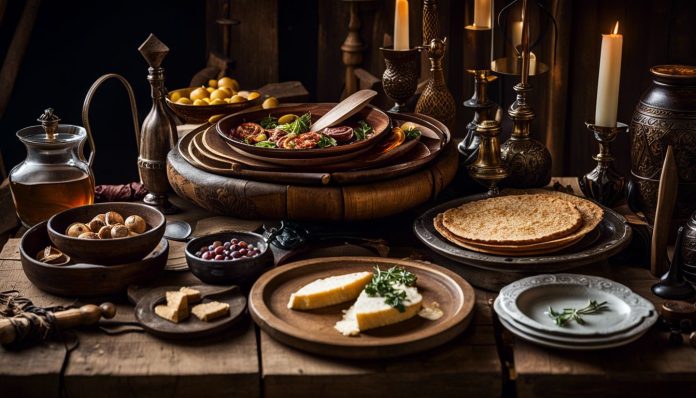Ever wondered what food was like in the Middle Ages? Interestingly, medieval cuisine was a mixed bag of lavish feasts for the wealthy and simpler fare for the peasants. This blog will take you on a fascinating journey through time to explore everything from basic diets to grand meals during this historical era.
Table of Contents
- 1 Understanding the Medieval Diet
- 2 The Influence of the Church on Medieval Cuisine
- 3 The Role of Social Class in Medieval Cuisine
- 4 Medieval Cookery Books and their Recipes
- 5 The Contrast between Wealthy and Poorer Diets in the Middle Ages
- 6 The Art of Food Preservation in the Medieval Era
- 7 The Significance of Herbs and Spices in the Medieval Kitchen
- 8 Traditional Medieval Meals and Etiquette
- 9 The Life of a Medieval Cook
- 10 Medieval Drinks and Their Importance
- 11 A Look at Some Popular Medieval Recipes
- 12 To Wrap Up
- 13 Frequently Asked Questions (FAQs)
Understanding the Medieval Diet
Cereals
In the Middle Ages, cereals played a critical role in sustaining the population’s diet. Barley, oats, rye, and wheat were most commonly consumed. These grains served as fuel for hardworking people and provided the necessary nutrients to keep them healthy.
These versatile ingredients could be transformed into bread or cereal dishes that formed an essential part of every meal. They offered varying flavors and textures depending on their preparation – whether baked, boiled, or ground into flour. Rice and potatoes only entered the culinary scene after 1530s due to trade expansions but failed to dethrone cereals from their staple status during this historical period.
Fruit
In the Middle Ages, fruit was widely seen as a luxury item due to its seasonal availability and preservation difficulties. Popular fruits included apples and pears, largely consumed in their dried form for longevity purposes. The use of other dry varieties like figs, dates, raisins and prunes often featured in sweet dishes or desserts for a hint of sweetness.
The culinary practices during this era were heavily influenced by medical theories which classified food on attributes such as hotness or coldness and moistness or dryness. Fruit fell under the ‘cool and moist’ category with beliefs it harbored multiple health benefits. Despite these perceived healthy properties and their occasional addition to savory dishes like stews or meat pies, fruits weren’t as coveted compared to other medieval diet components such as meats or spices.
Vegetables
In the Middle Ages, vegetables were a crucial part of daily diets. Cabbage, carrots, onions, leeks, and turnips found their place on most dinner tables due to their affordability and availability. Cooks often employed simple preparation methods such as boiling or stewing these nutritious offerings. Even privileged classes savored the humble vegetable’s complex flavors in addition to their meat dishes.
Their versatility made them integral to Medieval cuisine – they could serve as stand-alone side dishes or be incorporated into stews and soups for an enriched taste profile. The seasonal nature dictated by climate also added variety throughout the year with exciting fresh produce gracing plates during harvest seasons while preserved vegetables ensured steady supplies during leaner periods.
Regarding health benefits, certain veggies like onions and garlic were lauded for medicinal properties enhancing their value beyond mere sustenance. Therefore, despite meat and dairy holding higher importance in medieval food hierarchy due to perceived luxury status, vegetables nonetheless played a significant role in shaping the culinary practices of this era.
Fish and Seafood
Fish and seafood were an important part of the medieval diet. Commonly consumed fish included herring, cod, pike, carp, bream, perch, lamprey, and trout. These fish were often preserved through salting, drying, or smoking methods. Coastal and river-dwelling populations also enjoyed molluscs like oysters, mussels, scallops, and freshwater crayfish. The consumption of fish and seafood varied based on geographical location during medieval times.
While they were considered a luxury item and favored by the wealthy population, their availability played a significant role in the economy of Northern Europe. The Hanseatic League traded large quantities of herring from the North Sea and even sold smoked kippers as far away as Constantinople.
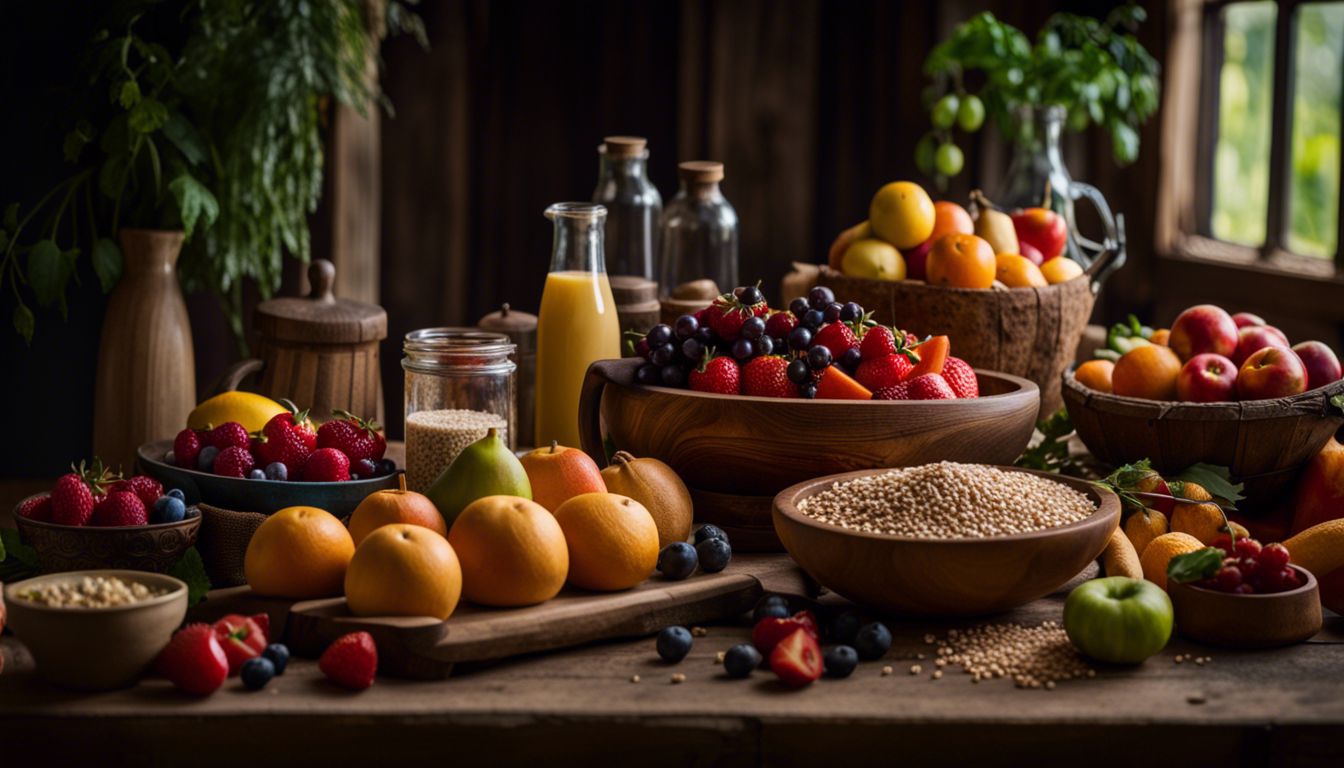
Meat
Meat was a staple in the medieval diet, enjoyed by both the wealthy and the more modest households. From beef to mutton, pork to poultry, various types of meat were consumed throughout the Middle Ages. The nobility often indulged in more expensive and exotic meats like peacocks, seals, porpoises, and even whales. The meat was commonly cooked in stews or roasted on open fires for flavor and tenderness.
While the rich had access to freshly killed meat from their own estates or markets, the poor would typically consume cheaper cuts of meat that required longer cooking times to become tender.
Dairy products
Dairy products played a significant role in the medieval diet, with cows being the primary source of these goods. Buttermilk, cheese, and curds and whey were all produced from cows during this time. Peasants and lower social classes relied on cows for their dairy produce, while the wealthy noblemen of aristocratic estates had access to a wide range of dairy products along with other luxurious foods like freshly killed meat, river fish, fresh fruit, and vegetables. These dairy products provided essential nutrients and flavors to meals in medieval times.
The Influence of the Church on Medieval Cuisine
The Roman Catholic Church had a significant influence on the diet and cuisine of the Middle Ages. One of the most notable ways in which the Church influenced medieval cuisine was through its regulations on when Christians were allowed to eat meat.
For approximately a third of the year, meat was forbidden, particularly during fasting periods such as Advent and Lent. To accommodate this restriction, compromises were made on what constituted “fish,” with certain aquatic animals like beavers and otters being classified as fish for dietary purposes.
This led to an increased consumption of fish and seafood during these fasting periods. Additionally, food choices were also influenced by the religious calendar, with feasts alternating with fasting days. The Church’s control over food practices served not only as a means of spiritual discipline but also shaped culinary traditions in medieval Europe.
The Role of Social Class in Medieval Cuisine
Social class played a crucial role in medieval cuisine, with stark differences between the diets of the wealthy and the poorer classes. The upper classes enjoyed a more varied and luxurious diet, while the lower classes had to make do with simpler and cheaper food options.
Wheat, considered a superior grain, was predominantly reserved for the nobility, while barley, oat, and rye were staples for the lower classes. Meat consumption also reflected social status; pork and chicken were more commonly found on the tables of wealthy aristocrats, while cod and herring were popular among northern populations.
Spices such as black pepper, cinnamon, nutmeg, ginger, and cloves were considered luxurious items that only the nobility could afford. In contrast, lower-class individuals relied heavily on preserved foods like bacon and pickled herring to supplement their diets. These social distinctions shaped not only what people ate but also how they prepared their meals during this fascinating period in history.
Medieval Cookery Books and their Recipes
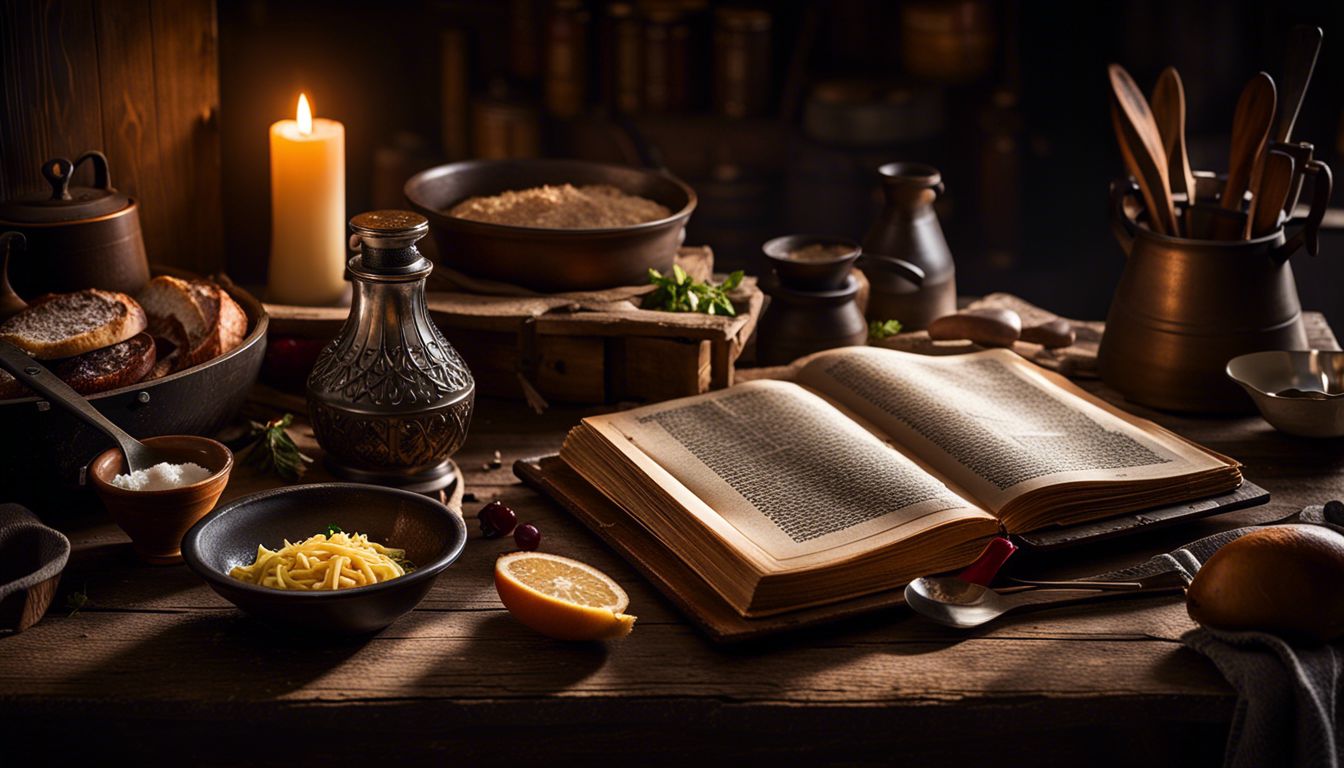
Jean de Wavrin’s Chronicles of English History
Jean de Wavrin’s Chronicles of English History is a significant manuscript associated with medieval cookery books and their recipes. This work provides valuable insights into the culinary practices of the Middle Ages, especially in the houses of wealthy noblemen.
It contains numerous recipes that showcase the extravagant and flavorful dishes favored by the upper classes during this time period. These manuscripts shed light on the use of valuable spices like caraway, nutmeg, cardamom, ginger, and pepper to enhance flavors. Additionally, they reveal common ingredients such as cane sugar, almonds, and dried fruits like dates, figs, and raisins that were frequently used in these medieval recipes.
The Forme of Cury
The Forme of Cury is a notable medieval cookery book that offers valuable insights into the diet and cuisine of the Middle Ages. This comprehensive collection provides a range of recipes, both savory and sweet, showcasing the ingredients commonly used during this period.
From meats to vegetables, spices to dairy products, and herbs to sugars, The Forme of Cury delves into the culinary practices and preferences of medieval Europe. With its detailed instructions and historical context, this cookery book offers a unique glimpse into daily life and culture in the Middle Ages.
A Boke of Kokery
A Boke of Kokery is a medieval cookbook that provides valuable insights into the culinary practices and food preparation techniques of the Middle Ages. This book, along with others like The Forme of Cury and Jean de Wavrin’s Chronicles of English History, offers a glimpse into the extravagant banquets and grand feasts enjoyed by the wealthy during this time period.
In A Boke of Kokery, readers can find recipes for various dishes such as jellies, pies, fritters, stews, and even sugar sculptures. It showcases the use of spices like saffron and sandalwood to enhance flavors, while also highlighting unconventional ingredients like boiled blood.
The cookbook serves as a testament to the diversity and creativity found in medieval cuisine.
The Contrast between Wealthy and Poorer Diets in the Middle Ages
The difference in diet between the rich and the poor during the medieval period was vast, influenced by factors such as access to different types of food, the influence of foreign trade, and varying cooking methods.
| Wealthy Diets | Poorer Diets | |
|---|---|---|
| 1 | The wealthy enjoyed a variety of freshly killed meat, including pork and chicken, as well as river fish. | The poor had limited access to meat, and their diets revolved more around preserved foods such as salted or pickled fish. |
| 2 | Fresh fruits and vegetables were abundant in the diets of the wealthy. | Preserved fruits, barley, oat, and rye were staples for the poorer classes. |
| 3 | Nutritious food ingredients like cane sugar, almonds, and dried fruits were commonly used in wealthier diets. | The lower classes had to make do with less refined and cheaper food options. |
| 4 | Valuable spices such as caraway, nutmeg, cardamom, ginger, and pepper were common in the meals of wealthy households. | The food of the lower classes was less flavored and spiced due to cost considerations. |
| 5 | The royal court even had a ‘spicery’ department solely dedicated to spices. | Such luxury was unattainable for the poorer classes. |
| 6 | Grand feasts for the wealthy featured extravagant dishes like peacocks, seals, porpoises, and whales. | The poor had to rely on simpler, less lavish meals. |
The Art of Food Preservation in the Medieval Era
Food preservation was a crucial skill in the medieval era, as it allowed people to store and preserve food for long periods of time. Various methods were employed during that time to keep food from spoiling. Drying was one common technique, where fruits, vegetables, and meat were dehydrated to remove moisture content and extend their shelf life. Smoking was another commonly used method, especially for fish and meat.
Salting involved covering the food in salt or brine solution to prevent bacterial growth. Pickling was also popular in the Middle Ages, particularly for vegetables like cucumbers and onions. The process involved submerging the produce in vinegar or brine along with various herbs and spices for flavoring. Fermentation played a role as well, with foods like sauerkraut being preserved through this method.
Salt itself played a significant role in preserving food during this time period due to its ability to draw out moisture and inhibit bacteria growth. It was used extensively on meats such as ham or bacon before being hung up to dry. Overall, the art of food preservation during medieval times allowed people to make their limited supply of fresh ingredients last longer while ensuring they had enough sustenance throughout the year.
Explore Medieval Times Deeper or Continue Reading…
The Significance of Herbs and Spices in the Medieval Kitchen
Herbs and spices held great significance in the medieval kitchen, adding flavor, aroma, and variety to the often monotonous diet of the Middle Ages. Common herbs like sage, parsley, caraway, and mint were grown and used throughout Europe as alternatives to expensive spices. They were easily accessible to both the nobility and lower classes alike. Spices such as ginger, pepper, nutmeg, cardamom, and saffron were highly prized for their exotic flavors but were limited to those who could afford them.
Herbs and spices not only enhanced the taste of dishes but also had medicinal properties that were believed to promote good health. The use of these ingredients reflected cultural traditions passed down through generations in medieval Europe. During this time period, trade routes connected different regions of Europe with distant lands like Asia and Africa. This facilitated a wide exchange of goods including precious spices like cinnamon from Sri Lanka or cloves from Indonesia.
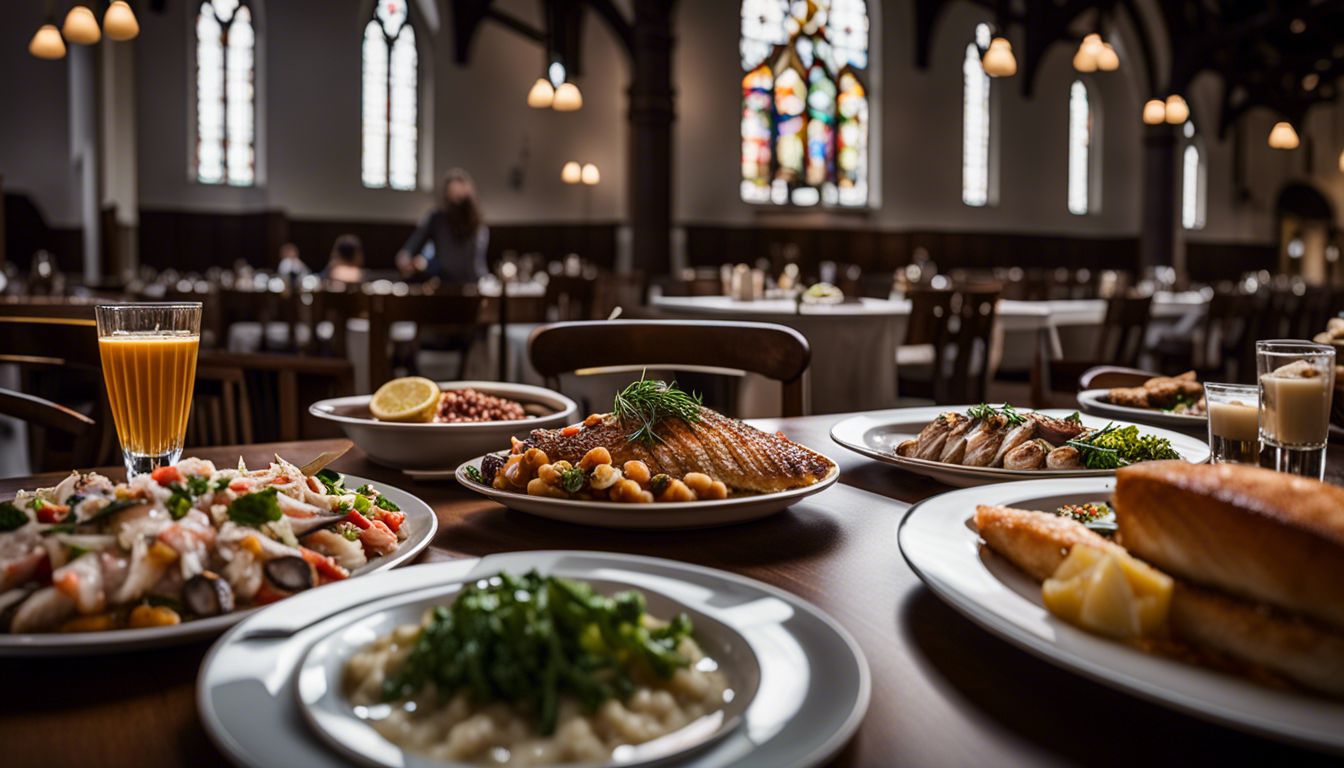
Spices became an important part of noble feasts where elaborate dishes showcased their wealth through their extravagant use of costly ingredients. For example, sugar was considered a type of spice due to its high cost; it was used sparingly in desserts and sweet dishes reserved for special occasions. The significance of herbs and spices extended beyond just culinary purposes; they played a role in religious rituals as well as symbolic meanings attached to certain plants or flowers during celebrations or ceremonies. Moreover, they added depth to medical remedies which formed an integral part of apothecaries’ manuals during that era.
Overall, herbs and spices provided much-needed excitement to mundane meals while also representing social status within medieval society. Their availability depended on factors such as trade routes, wars between kingdoms impacting access to certain goods (e.g., when Constantinople fell under Ottoman rule), making them valuable commodities in terms not only financial value but also cultural richness within culinary practices at that time period.
Traditional Medieval Meals and Etiquette
- Meals in the Middle Ages were typically eaten in a communal setting, with family members and guests gathering around a large table. Etiquette during meals was highly structured and strict, with specific rules for behavior that varied based on social class. Meals began with a prayer or blessing, followed by the head of the household or host distributing portions of food to each guest.
- Utensils such as knives, spoons, and sometimes forks were used for eating, although fingers were also commonly used for certain foods. Table manners emphasized the proper use of utensils, not talking while chewing, and avoiding spills or drops onto the tablecloth. Meals often consisted of multiple courses, with each course, featuring different dishes and flavors.
- The order in which dishes were served was carefully planned to create a balance of flavors and textures throughout the meal. During meals, entertainment such as music or storytelling might be provided to enhance the dining experience.
- It was customary for hosts to provide ample amounts of food and drink for their guests, even if it meant going into debt or borrowing resources.
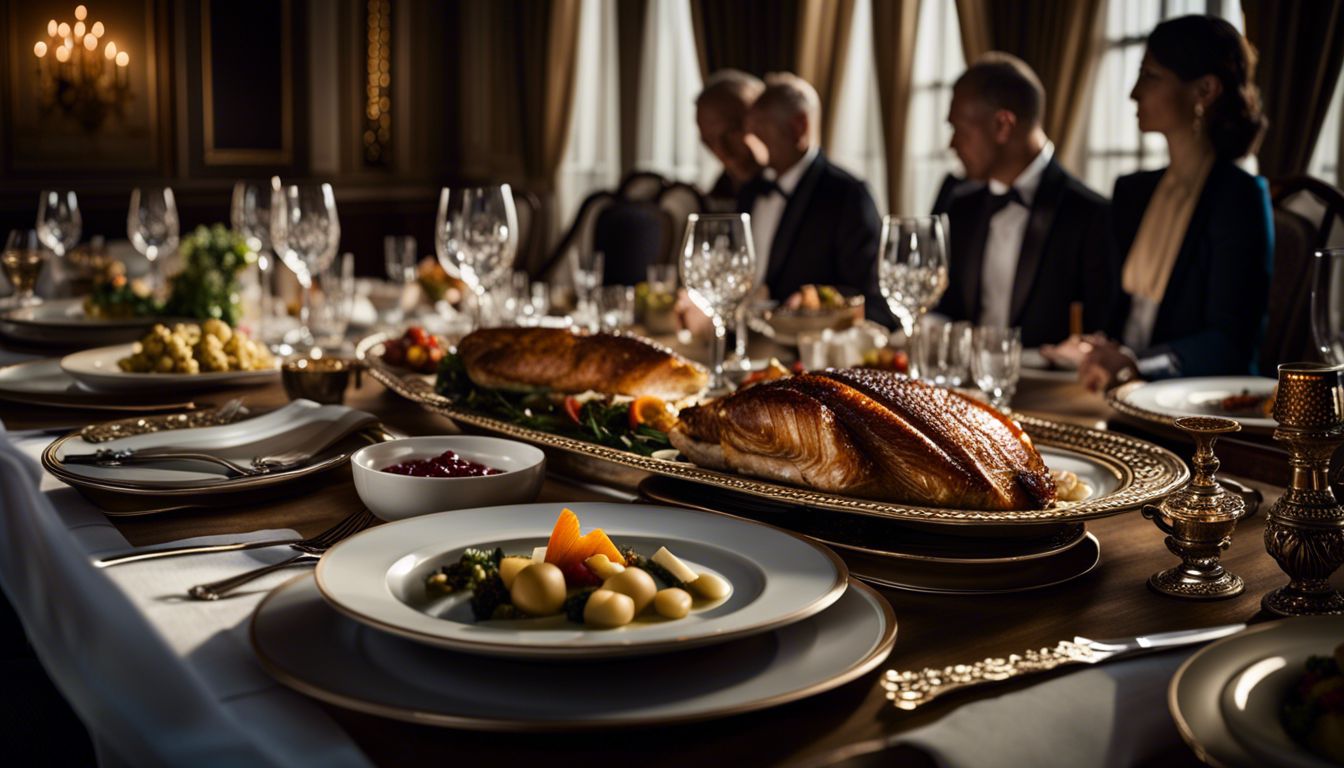
The Life of a Medieval Cook
Medieval cooks faced a challenging and demanding life in the kitchen. They were responsible for preparing meals fit for kings, nobles, and other members of the social elite. These skilled individuals worked long hours in hot kitchens filled with smoky fires and buzzing insects.
Their job involved not only cooking but also sourcing ingredients, managing staff, and ensuring food safety. Medieval cookery manuscripts included recipes that were prepared in wealthy households and featured elaborate dishes like peacocks and whales.
However, cooks serving the lower classes faced different challenges as they had to work with more basic ingredients such as barley, oats, and rye. Despite these challenges, medieval cooks played a vital role in shaping the cuisine of the Middle Ages through their culinary skills and creativity.
Medieval Drinks and Their Importance
Medieval drinks played a crucial role in the daily lives of people during the Middle Ages. Alcoholic beverages were preferred over water, as they were safer to consume due to the brewing process that killed bacteria and other contaminants.
Beer or ale was particularly popular in northern parts of Europe, while wine became increasingly favored in southern regions. The importance of drinks extended beyond mere hydration; they were deeply ingrained in social rituals and cultural customs. Feasts and banquets would feature an array of drinks to accompany the lavish meals, with different types of alcohol served according to social status and occasion. Spices like black pepper, cinnamon, nutmeg, ginger, cloves, and even herbs were used to add flavor and enhance the taste of these drinks.
Alcoholic beverages also served as a form of currency for trade purposes within medieval societies. The importance of alcoholic beverages during Medieval times went beyond just quenching thirst; it was deeply intertwined with social customs and cultural practices.
A Look at Some Popular Medieval Recipes
In this section, we will explore a few popular medieval recipes that were enjoyed during the Middle Ages.
Cabbage chowder
Cabbage chowder is a hearty and delicious dish that was popular during the Middle Ages. Made with a combination of cabbage, onions, leeks, saffron, and aromatic spices, this soup was enjoyed as both a starter or a main course.
To add even more flavor, it was often served with toast and fried bacon. Today, you can recreate this medieval recipe at home and experience the taste of history. Cabbage chowder provides a fascinating glimpse into the culinary traditions and ingredients used during the Middle Ages. So why not step back in time and enjoy a unique and alternative Christmas dinner by trying out this traditional dish?
Mushroom pasties
Mushroom pasties were a popular medieval dish that consisted of savory pastries filled with mushrooms. Mushrooms were commonly used in medieval cooking due to their abundance and ease of cultivation.
They provided a rich and earthy flavor to the pasties, which were often enjoyed by both the wealthy and poorer classes. These pasties would have been baked until golden brown, creating a crispy crust that contrasted with the tender filling inside.
Mushroom pasties are just one example of the diverse and flavorful recipes that can be found within the diet and cuisine of the Middle Ages.
Lamb or mutton stew
Lamb or mutton stew was a popular and hearty dish during medieval times. This delicious stew consisted of tender lamb or mutton, cooked in a flavorful broth with an array of herbs, onions, spices, eggs, and verjuice—a tart juice made from unripe grapes.
The stew was rich in flavor and often served as a comforting meal for both the upper classes and peasants alike. It’s fascinating to imagine how this simple yet satisfying dish brought people together at the dining table during the Middle Ages, providing warmth and nourishment on cold winter days.
Haddock in a tasty sauce
One of the delicious recipes from the Middle Ages is “Haddock in Tasty Sauce.” This dish would have been enjoyed by the wealthy during medieval times. The recipe calls for haddock fillet, onions, oil or butter for frying, white pepper, breadcrumbs, brown ale, and salt.
It showcases the use of flavorful ingredients commonly found in medieval cuisine. Spicy sauces were popular during this time period, and there were dedicated professionals known as saucemakers who specialized in creating these delectable accompaniments to meals.
Cooked dishes in the medieval kitchen were heavily flavored with valuable spices like white pepper and herbs to enhance their taste profiles. So if you’re looking to try a unique historical recipe, why not give Haddock in Tasty Sauce a try?
Piment or medieval mulled wine
Piment, also known as medieval mulled wine, was a beloved drink during the Middle Ages. This warm and aromatic beverage was heavily spiced and flavored with a variety of herbs and spices such as cinnamon, ginger, cloves, nutmeg, and marjoram.
It was often served at grand feasts and banquets in medieval Europe. The recipe for Piment included luxurious ingredients like saffron and white sugar, giving it a rich and indulgent flavor. Recreating this traditional drink can provide a unique twist to your Christmas dinner or festive celebration. Experience the taste of history by trying out this authentic recipe from the Middle Ages.
To Wrap Up
In conclusion, exploring the diet and cuisine of the Middle Ages provides a fascinating glimpse into the culinary practices of medieval Europe. From the lavish feasts enjoyed by the wealthy nobility to the simpler fare of the lower classes, food played a central role in medieval life.
The use of spices, preservation methods, and traditional recipes all contributed to the rich tapestry of medieval cuisine that has captured our curiosity for generations. Through examining these historical aspects, we can gain a deeper appreciation for how food shaped society during this time period.
Frequently Asked Questions (FAQs)
1. What were the main foods consumed during the Middle Ages?
The main foods consumed during the Middle Ages included grains such as barley and wheat, vegetables like cabbage and onions, meat from animals like pigs and chickens, and dairy products including cheese and butter.
2. Were spices commonly used in medieval cuisine?
Yes, spices were commonly used in medieval cuisine to enhance the flavors of dishes. Some popular spices included cinnamon, cloves, ginger, nutmeg, and pepper.
3. Did people drink water during the Middle Ages?
While water was available for drinking during the Middle Ages, it was often contaminated due to poor sanitation practices. As a result, many people chose to drink ale or beer instead since these beverages went through a boiling process that made them safer to consume.
Social status had a significant impact on diet during the Middle Ages. The wealthy could afford a varied diet that included more expensive ingredients such as meat and exotic spices. In contrast, peasants had a simpler diet based primarily on grains and vegetables with limited access to meat or luxury items.

